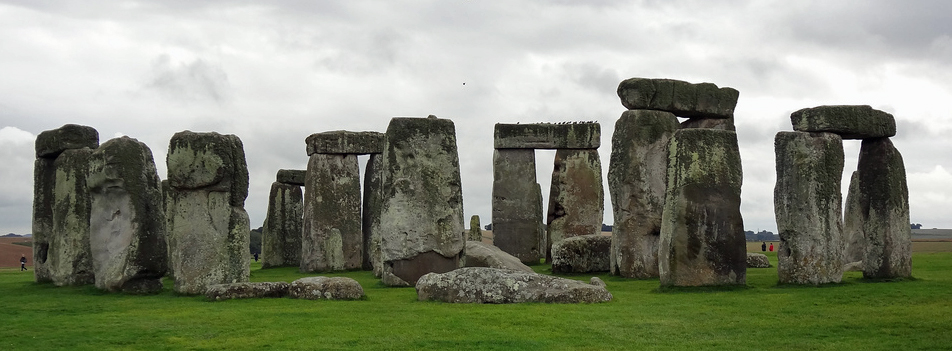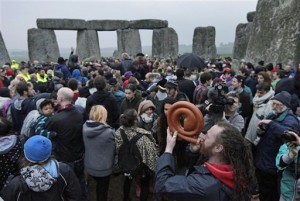
Stonehenge (Photo: Rupert Jones via Flicker/Creative Commons)
As crowds converged on Stonehenge last week for the summer solstice, a new study based on 10 years of archaeological investigations revealed the ancient monument was built to unify all of the people of Britain.
For years, experts have tried to uncover the many mysteries of Stonehenge, one of the world’s most famous prehistoric sites, which was built about 4,500-to- 5,000 years ago in South Central England.
Stonehenge has long been thought to be a prehistoric observatory, a sun temple, a place of healing and a temple of the ancient druids. But a team of archeologists, working on the Stonehenge Riverside Project, rejected all those possibilities.
According to the research team, the Neolithic and Bronze Age structure was built after years of struggle and conflict between the people of eastern and western Britain.
The stones symbolize the ancestors of different farming communities in Great Britain, according to the researchers.
The building of Stonehenge also corresponded with a shift of identity for the British.
“When Stonehenge was built, there was a growing island-wide culture – the same styles of houses, pottery and other material forms were used from Orkney to the south coast,” said Mike Parker Pearson, a member of the Stonehenge Riverside Project. “This was very different to the regionalism of previous centuries. Just the work itself, requiring everyone literally to pull together, would have been an act of unification.”
The construction of Stonehenge required thousands of laborers to move the monolithic stones from as far away as west Wales. Many more people were needed to shape and erect the stones after such a long journey.
Archeologists believe Stonehenge was built in stages from about 3000 BC to 2000 BC.
The location for Stonehenge wasn’t a random choice, according to researchers. The spot had a long-held, special significance to the prehistoric people of Britain.
The research team found that Stonehenge’s collection of stones, which are aligned with the solstices, actually sits on a series of natural landforms that form an axis between the directions of midsummer sunrise and midwinter sunset.
“When we stumbled across this extraordinary natural arrangement of the sun’s path being marked in the land,” says Parker Pearson, “we realized that prehistoric people selected this place to build Stonehenge because of its pre-ordained significance. This might explain why there are eight monuments in the Stonehenge area with solstitial alignments, a number unmatched anywhere else. Perhaps they saw this place as the center of the world”.























Perhaps it’s time for the world to build another one of these, as it seems that nothing else is working to lessen conflict in the world.
This will quickly remind the people of britain the need for ages of unification.
I just don’t believe this theory is true. Doesn’t make sense to me.
Hi Sharon,
Thanks so much for reading and for your comment!
Why not also tell the folks who worked on the project too?
http://www.sheffield.ac.uk/archaeology/research/stonehenge
Thanks Again,
Rick P.
This really is not news. scholars , and “New ager” have been telling us these things about Stonehenge for decades!!!
I spent a year studying Stonehenge,Calanish etc.while at College of DuPage (Glen Ellyn Il.) At the time Stonehenge Decoded (Hawkins G.) and Stonehenge Of the Kings(Cramdon P.) were the most up to date information that Chicago’s Newberry Library could provide. Astrophysicist Hawkins only speculated on its purpose while Cramdon attempted to explain it terms of the knowledge of his era. At best he was only partly correct. What unit measurement was it based on? Was it the Greek foot or the Roman foot? Or perhaps some other unit of measure? The initial markers that were ultimatly used to build Stonehenge I date back to the end of the last Ice Age.It took a long time to develop the knowledge needed to build the ‘modern’ version. Was the henge intended to be built to a scale expressing celestial measurements? Time and further research may answer the question. Could the british foot be much older than we think? I anxiously await Pearson et all’s further discoveries.
These people had nothing but materials, grit and cool water. That’s how they got thru a lot of there days of desire. Seed water and sweat is how to grow food.
I suggest that the best way of finding out why Stonehenge was constructed and how it was constructed over 4,000 years ago is to bring in giant cranes and dismantle the whole project, move all the stones aside, check out the foundation to see what it was built on,perhaps to a depth of four feet..that should give us some idea on who built it and why?
My guess is, it was built as a temple for worshipping the Sun.
My second guess is…those brilliant minds of 4,000 years ago KNEW that future BRITS and people from all over the world would stop by and GAZE at the stones and say to themsleves, while scratching their heads..”What the hell was this built for?”
Are we living with the “mindset” of Bronze Age thinkers, or is this the 21st century of scientific discoveries? Tare down Stonehenge and find out!